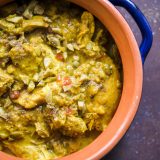In Marrakech, real life—and real food—can seem lost under a veneer. Snake charmers taunting dazed cobras. Monkey handlers choking their charges to amuse. Menus larded with the tasteless, soppy and safe-for-tourists.
Peeling back that layer to see and taste truly Morocco requires diving into the back alley scrum of the souk—the winding maze of market where ochre walls the color of the clay plains and hills beyond the city close in. Where charcoals glow under clay pots, steam and smoke billowing, enveloping you in a breath of lamb fat and crisped sardine skins. Where teenagers disorient you in the warren of shops, stalls and dark doorways, then “rescue” you. For cash.
And in my case, it required crouching on a floor deep with ash and dirt in the wood-fired, subterranean furnace room of a public bathhouse. It meant sweating with the workers—the glow of the roaring open flame our only light—as we tore hunks of thick flatbread, dredging it through a platter of what was one of the most succulent, most crave-worthy meals of my life.
It was tangia, both the food and the large urn-style clay pot in which it cooked. Fall-apart tender hunks of lamb bathed in a thick, but spare broth rich with saffron, turmeric, cumin, ginger, garlic and lemon. Too dry to be a stew, too moist for me to resist mopping the juices with bread, our only utensils. So savory and aromatic, it overpowered even the soot.
But understanding this dish demanded a journey. It began the day before and would involve snake charmers, sides of meat the size of bicycles, a taxi driver who knew just the right convenience shop clerk, and—of course—a bathhouse furnace.
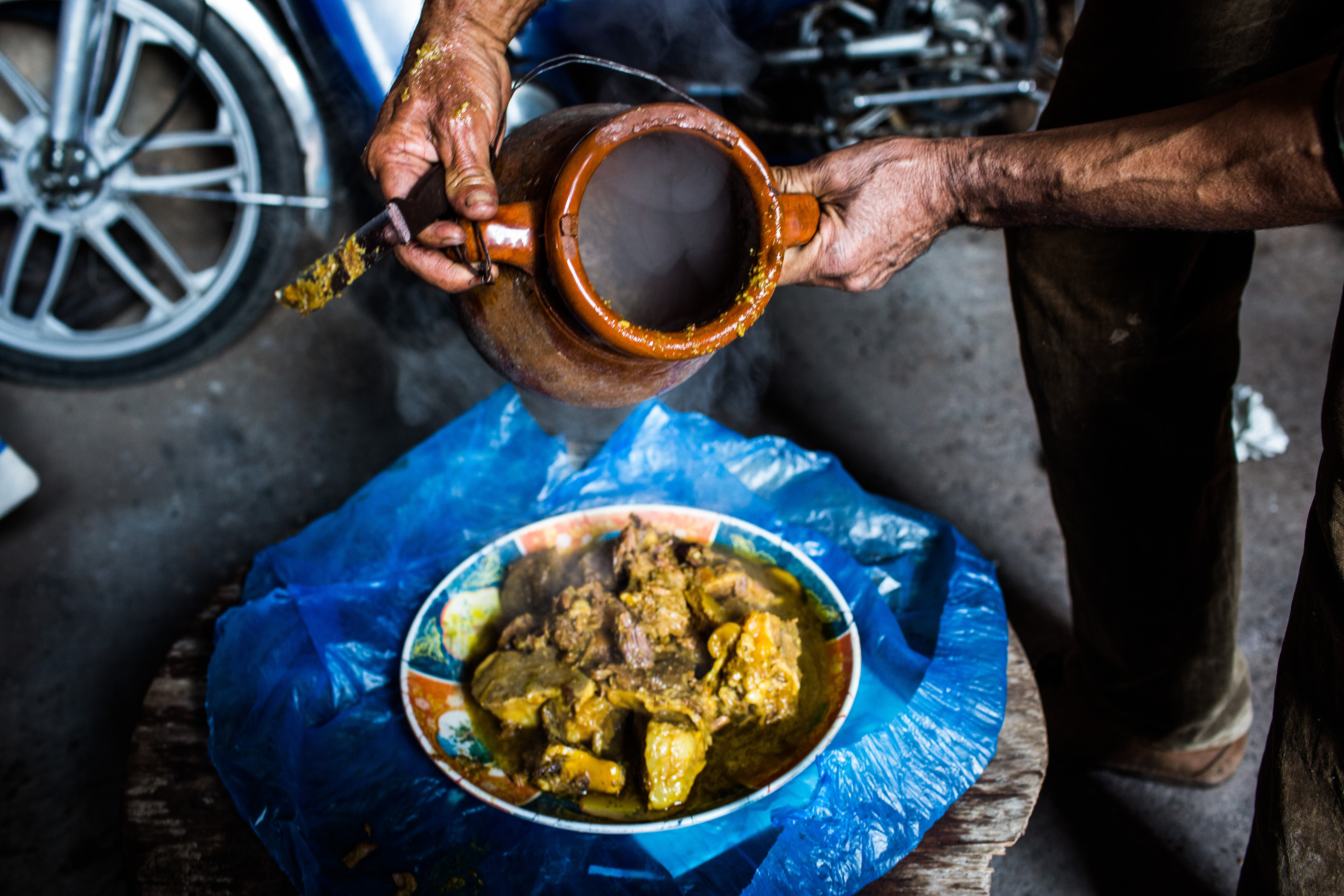
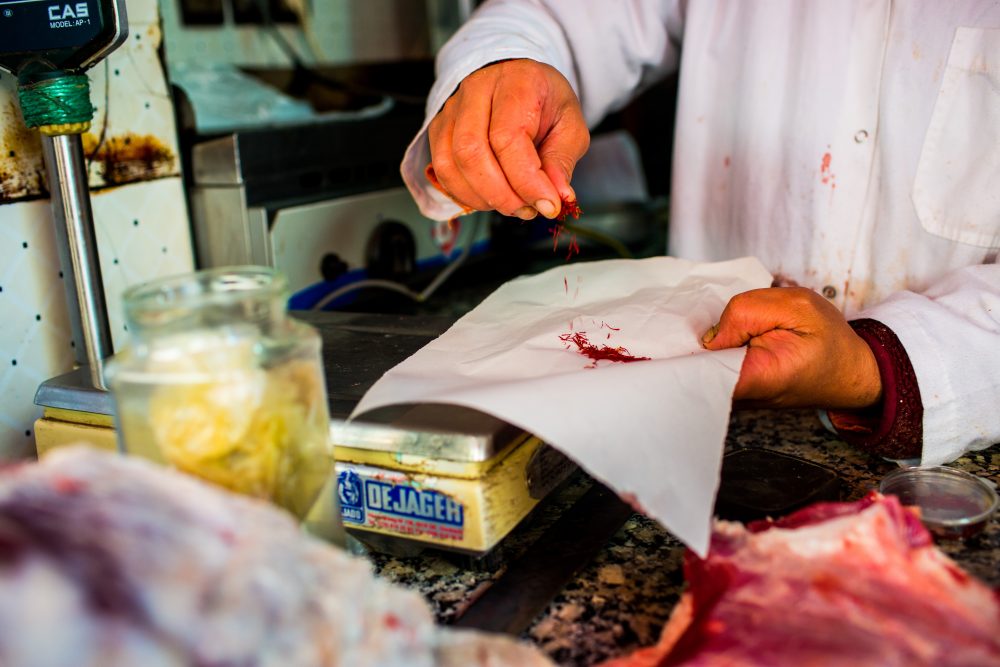
Jemaa el-Fnaa
The center of Marrakech—Morocco's fourth largest city, nestled at the foothills of the imposing Atlas Mountains—is dominated by a massive square, Jemaa el-Fnaa. It's a riot of whirring scooters weaving between pedestrians, camel rides, shops and stalls plying clichéd pottery. It is a tourist trap and to be avoided.
I'd come only for the ATM. And fled quickly—an escape hastened when a man pushed at my face the object of my childhood nightmares, a king cobra with neck at full flair—into the outskirts where tiny restaurants crowd narrow streets. Outside each, long, narrow hibachi-like grills filled with glowing coals. Nestled into them, the clay urns.
Aromas of saffron and cumin drew me inside Chez Lamine, a three-story restaurant tiled floor-to-ceiling in blues and whites. At each table, families clustered around platters of meat, grabbing hunks with bread. My order came quickly, the waiter pulling parchment off the urn's wide opening, then pouring out tender hunks of lamb in a rich, saucy heap onto a platter. The bread was plentiful and I ate too much, sprinkling everything with a blend of coarse salt and cumin.
Tangia is native to Marrakech, far less familiar than Morocco's national dish—tagine, a similar family of stews made in squat, conical pots. Tangia originated as something single working men would make, pooling their cash to buy ingredients, then taking the urn to the backside of a hamman—Morocco's answer to the Turkish bath—where workers tending the fire would cook it for them for the price of a few dirhams.
Most surprisingly, tangia is cooked this way still, though no longer limited to bachelors. My photographer was dismissive of the meal we'd enjoyed. Real tangia isn't restaurant food. It's not a menu item. It's a process. And one—given the apparent social complexities of how it is cooked—that seemed unlikely I could learn.
Alimentation Générale
Youssef Boufelja was only supposed to drive me a short way. But as we moved through the walled city, the conversation turned to tangia, a dish the taxi driver said he makes frequently in the traditional way. Though puzzled by my excitement, he agreed to show me. Which is how we ended up navigating the nether regions of the souk, parking in front of an unmarked butcher stall with a narrow counter, a small window and a massive side of lamb hanging in the street by a hook.
Boufelja hoisted the lamb off the hook and set it on the counter, telling the man behind it to give us several kilos of the shank. For 150 dirhams—about $16—we received a grocery bag of the meat—trimmed to large chunks—as well as a hefty pinch of saffron and a fistful of preserved lemons.
From here, we walked a few hundreds yards deeper, the soundtrack a buzz of scooters; the clop of donkeys pulling wooden carts heaped with fresh mint destined; the thin, sharp crack of tin being punched by hand with hammer and nail, to be twisted into intricately patterned lanterns; the Islamic call to prayer bellowing over loudspeakers. We stopped at a similar stall, this one marked with Alimentation General, or grocery shop.
Behind a counter similar to the butcher's, stacks of powdered flan mix—thousands of them—large tangia urns and massive kegs of preserved lemons. For 50 dirham, the man at the counter took our meat and saffron and dropped them into an urn. He scowled at our lemons; his were better. He added cumin and ginger, shaking the pot gently to mix. Copious olive oil, butter, a head's worth of garlic cloves. He capped the opening with parchment, tying it tight with twine, then wrote my name on the top and gave it a hearty shake. His role was finished.
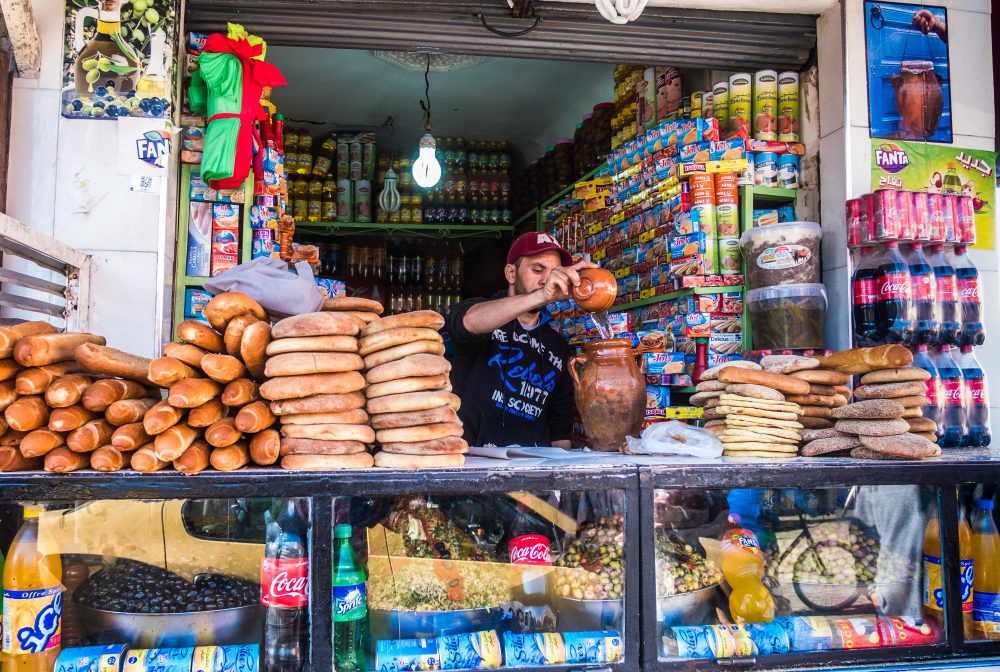
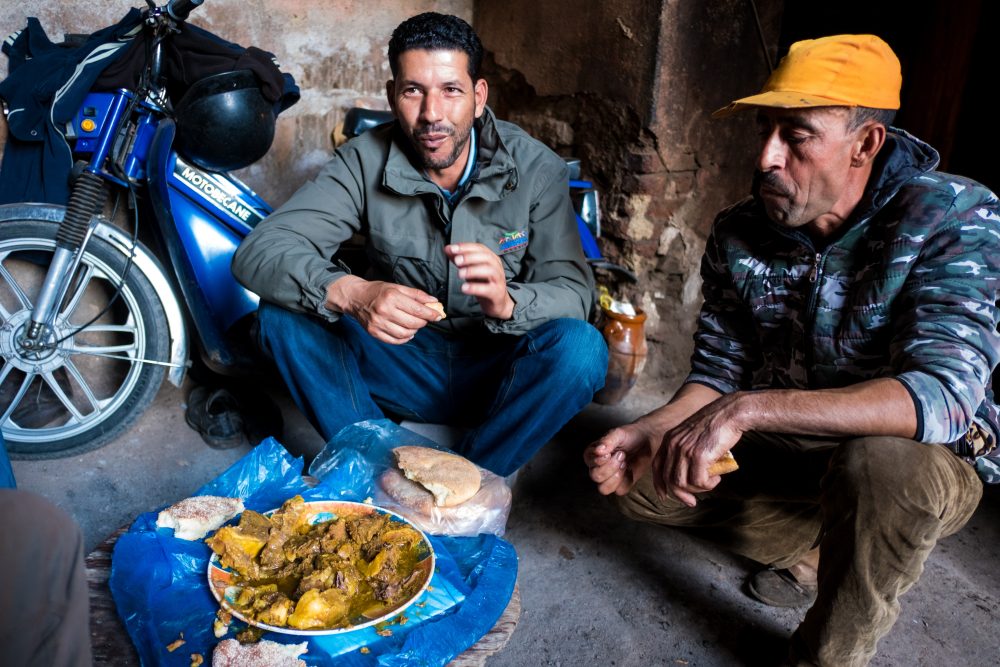
HAMMAM
A few hundred yards away, we found the hammam, one of the oldest in Marrakech, a low, white-washed building with separate entrances for men and women. We headed to the back, a long, narrow alley leading us to ash-covered stone stairs that descend into a dirt-floored room dark with soot, a fire blazing from the opening of a massive clay furnace. A hammam is always heated by wood fire, and across the city mountains of olive and orange wood depots fuel the industry.
The man heaping wood into the furnace shows no surprise by our arrival. He's been doing this for 18 years and on a normal day will cook 20 or 30 tangias. During Ramadan, it can be 100. He took our pot and nestled it into ashes near the opening of the fire before shoveling bright red charcoals around it halfway up the urn.
How will he know when it is done? He will touch the parchment with his hand, then smell it. It should have a “good smell” and the paper should be brittle, ready to crack. He told us to come back in four hours.
When we do, there is a richness to the air. Wood smoke, yes. But lemon and and saffron, ginger and garlic, too. I offer to share the meal with him, and he pulls out a plastic platter, unceremoniously dumping the contents of the tangia onto it. I'd brought flatbread and we tear hunks with which to lap up the meat and juices.
Despite—or perhaps because of?—the ambiance—dirt, ash and darkness all around us, a blazing fire—this is one of the most intense meals I've ever eaten. The meat savory and rich without overwhelming. And so tender, like the most carefully tended barbecue. The play between the saffron, cumin, turmeric and lemon at once familiar yet foreign.
Tangia would not be a direct translation. To start, the lamb. Americans have little taste for it. But the richness of lamb was essential for this dish. Our solution—boneless, skinless chicken thighs. In addition to having a similar richness, they stay moist and can become tender enough to fall apart, as the lamb did—key for utensil-free eating.
The cooking method also, obviously, wasn't going to work. But because chicken thighs cook more quickly than lamb shank, we were able to move the dish out of the urn and coals and onto the stovetop in a Dutch oven without sacrifice. Most of the seasonings stayed the same, with ample turmeric, saffron and cumin the biggest players.
The challenge was the preserved lemons, which lend a clean, but not overwhelming brightness and acidity (see sidebar), but can be hard to find here. After a bit of trial and error, we settled on a generous amount of lemon zest and juice stirred in at the end, an effort to keep the aroma and taste fresh. This was a start, but the brininess of the preserved lemons—they are rubbed with coarse salt—was still missing. Though not traditional, adding chopped green olives made up for it.
The result was simple, deeply aromatic with flavors at once rich, but also light—a result of the interplay of lemon and saffron. Sopped up with tender pita bread, it was as delicious as my furnace room feast. No soot or king cobras needed.
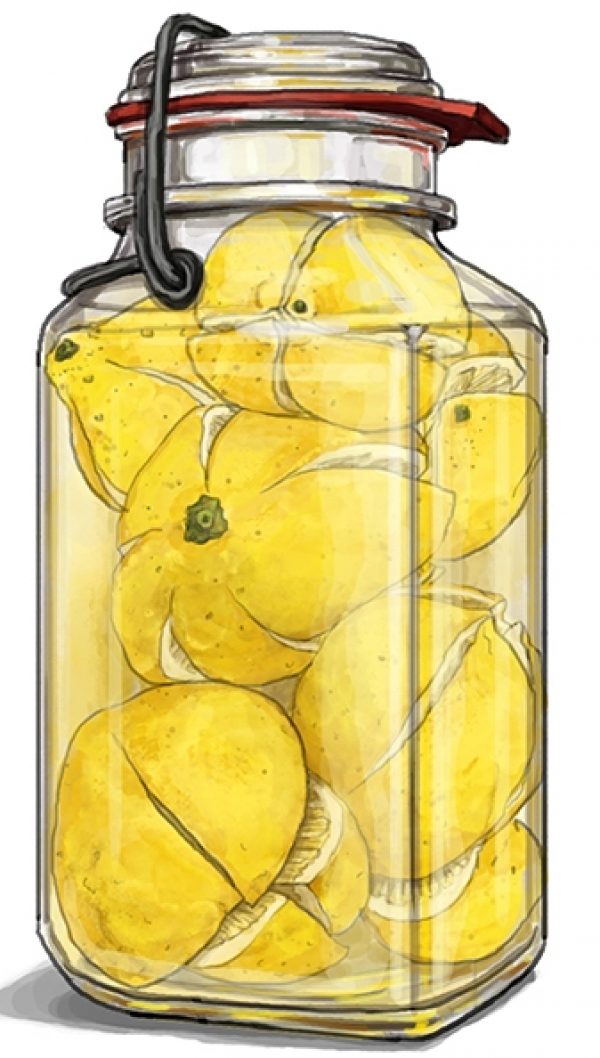
Across North African and some Southeast Asian cuisines, preserved lemons—whole lemons pickled in a brine of salt and lemon juice, sometimes with spices—are an essential seasoning, often used to brighten meat-rich stews. They are particularly popular in Morocco, where fistfuls of the tender pulp and skin are added to tangia and numerous varieties of tagine, adding a sweet-salty-tart punch that elevates without overpowering. Though easy to make—deeply score whole Meyer lemons, rub generously inside and out with kosher salt, then submerge in lemon juice for several weeks—and increasingly available, at Milk Street we wanted a speedier alternative. To replicate the flavor of the preserved lemons used in traditional tangia recipes, we opted for generous amounts of lemon zest and juice, as well as chopped green olives (for saltiness) added at the end of cooking to preserve their fresh flavor.
Related Recipes
March-April 2018

Sign up to receive texts
Successfully signed up to receive texts!
We'll only send our very best offers - Like a $15 store credit to start.
By entering your phone number and submitting this form, you consent to receive marketing text messages (such as promotion codes and cart reminders) from Christopher Kimball's Milk Street at the number provided, including messages sent by autodialer. Consent is not a condition of any purchase. Message and data rates may apply. Message frequency varies. You can unsubscribe at any time by replying STOP or clicking the unsubscribe link (where available) in one of our messages. View our Privacy Policy and Terms of Service.
